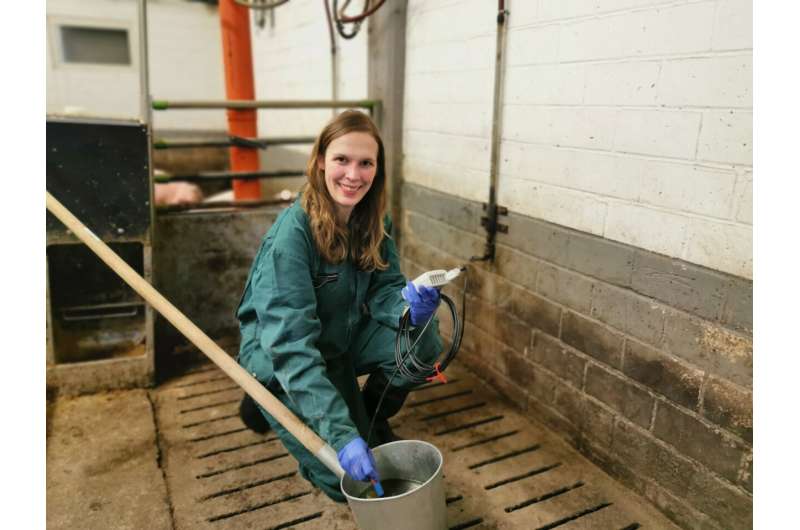This article has been reviewed according to Science X's editorial process and policies. Editors have highlighted the following attributes while ensuring the content's credibility:
fact-checked
peer-reviewed publication
trusted source
proofread
Acidification of slurry to reduce ammonia and methane emissions

Ammonia released into the environment is a major problem. Agriculture is considered the most prolific polluter—it is responsible for 95 percent of these emissions in Germany. The colorless, acrid gas is toxic in higher concentrations. It can moreover contribute to the eutrophication of water bodies and form particulate matter by reacting with other air pollutants.
Its conversion to nitrous oxide, a greenhouse gas that is about 300 times more harmful to the climate than carbon dioxide, is considered particularly problematic. Nitrous oxide is estimated to contribute around ten percent to global warming.
The EU therefore now imposes national ammonia emission limits on its member states. But how can these be achieved without farmers having to carry out extremely costly new constructions or conversions of their livestock buildings?
"Over the past three years, we have been testing a technology that can be used to retrofit existing barns," explains Dr. Veronika Overmeyer of the Institute for Agricultural Engineering (ILT) at the University of Bonn.
Acidified slurry for clean air
Together with their project partners, the companies SF-Soepenberg and Hölscher + Leuschner, the researchers used a tried-and-tested method for this purpose: the acidification of slurry with sulfuric acid. Pigs and cattle are often kept on so-called slatted floors. Their excrements fall through slits in the floor into the slurry channel below. There they are stored until they are used as fertilizer at the beginning of the next growing season.
"Ammonia is continuously released from the fecal-urine mixture," Overmeyer says. "Adding acid causes ammonia to be present as ammonium, which cannot escape in a gaseous form and thus remains in the slurry." This mechanism has been known for a long time. In Germany, for example, acid is already added to some of the slurry when it is spread on the fields. However, this does not control the outgassing that occurs in the barn or during slurry storage.
Acidifying the excrements directly in the slurry channel can be dangerous under certain circumstances, as toxic hydrogen sulfide can be produced. "This is why we moved this process out of the barn," Overmeyer emphasizes: "Every few days, we pump the slurry into a special agitation tank where it is mixed with sulfuric acid. The freshly acidified slurry is then pumped back into the slurry channel."
This means it can continue to be stored in the barn, while at the same time reducing ammonia emissions. These fell by just under 40 percent in the study. If the method is optimized, values of even more than 60 percent are conceivable. Ammonia emissions from fertilization with the pre-treated slurry are also significantly lower. In addition, because the acidified slurry contains higher amounts of nitrogen and sulfur than normal, it has an even better fertilizing effect.
Good news for the climate
Another observation was also unexpected: Acidification also suppressed the formation of methane, a very potent greenhouse gas. 10 to 15 percent of man-made methane comes from slurry storage. "Our method enabled us to reduce methane emissions by two-thirds," explains Prof. Dr. Wolfgang Büscher from the ILT, who supervised the study. "So we're killing two birds with one stone."
The retrofit does not come for free. However, it is comparatively inexpensive compared to costly conversions or even new construction, with additional benefits for the farmer in the form of improved fertilization. Nevertheless, the solution currently falters on account of the German legislative situation. This stipulates that the addition of acid to stored slurry is only permitted if the slurry channel has previously been sealed with special liner.
"That makes the retrofit much more expensive," Overmeyer says. "Yet studies show that this measure is not necessary, because despite the slightly lower pH in the slurry, the walls of the slurry channels do not wear significantly faster."
Her hopes are now pinned on a new draft bill that proposes to abolish the statutory sealing requirement. However, this has been on the table for years and has not yet been passed into law. "I find this somewhat annoying," Overmeyer says: "On the one hand, we expect farmers to be more environmentally friendly, and on the other hand, we put obstacles in their way."
For her study, she spent a year and a half comparing two fattening pig barns (with and without slurry acidification) at the Faculty of Agriculture's Teaching and Research Station. "Long-term studies of this kind are a rarity, because they are so costly," emphasizes her doctoral supervisor, Prof. Büscher. "With the Frankenforst campus, we have one of the few facilities in this country where this is even possible."
The study is published in the Journal of Environmental Management.
More information: Veronika Overmeyer et al, Acidification of slurry to reduce ammonia and methane emissions: Deployment of a retrofittable system in fattening pig barns, Journal of Environmental Management (2023). DOI: 10.1016/j.jenvman.2023.117263
Journal information: Journal of Environmental Management
Provided by University of Bonn




















